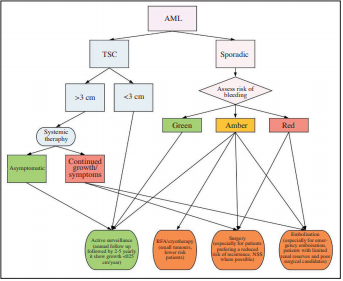Renal angiomyolipomas (R-AMLs) are rare benign tumors, which occur sporadically and in association with genetic conditions such as tuberous sclerosis complex (TSC) and lymphangioleiomyomatosis (LAM). The key clinical concern is life-threatening hemorrhage. There is uncertainty about the optimal management strategy for patients with R-AMLs. We aim to review the evidence and provide a protocolled approach for the management of R-AMLs. A literature search of R-AML was conducted using MEDLINE and EMBASE for articles published between January 1990 and March 2020. Patient with TSC and sporadic cases were included. Treatment strategies, including active surveillance, surgery, selective arterial embolization (SAE), ablation, and systemic therapies, were reviewed. Outcomes from contemporary case series of active surveillance, surgery, and SAE were collated. There were no randomized controlled trials on this topic. The retrospective case series reviewed showed that many R-AMLs can be managed safely with active surveillance. Tumor size is the most important predictor of bleeding, and other factors such as rate of growth, women of child-bearing age, aneurysm size, and symptoms should be considered when deciding on prophylactic treatment. There is limited evidence for the traditional 4-cm cutoff for treatment, which may lead to overtreatment. The primary intervention options are SAE and surgery; whereas SAE is a less invasive option, nephron sparing surgery offers a lower risk of recurrence. Both appear to have similar morbidity, and the current evidence does not recommend one over the other in most cases. Thermal ablation has promising results but has only been trialed in small case series. Patients with TSC can be offered mammalian target of rapamycin inhibitors of which everolimus appears to cause the greatest shrinkage of tumors with an acceptable side-effect profile. R-AMLs should be assessed for their risk of bleeding. Low-risk tumors should be treated with active surveillance. High-risk tumors should be treated with SAE or surgery. Systemic treatments are the first-line of treatment for patients with TSC to preserve renal parenchyma.
Cite this article as: Vaggers S, Rice P, Somani BK, Veeratterapillay R, Rai BP. Evidence-based protocol-led management of renal angiomyolipoma: A review of literature. Turk J Urol 2020; 47(Supp. 1): S9-S18.

.png)


.png)
